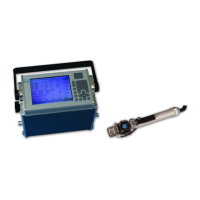Calibration
CIRAS-2 Operator's Manual Version 2.04
- 144 -
through a 30 cm tube. The flow rate from the gas cylinder should be set so that there is a small excess,
say 100-200 ml/minute, flowing to atmosphere. The total flow is then 300 to 400 ml/minute.
ON NO ACCOUNT PLACE THE VENT TUBE INTO WATER TO INDICATE SURPLUS FLOW. IF
CIRAS-2 INGESTS WATER, IT IS LIKELY THAT THERE WILL BE DAMAGE TO THE CELL
SURFACES, THE DETECTOR WINDOWS, THE IR SOURCE, THE PUMPS AND THE MASS
FLOWMETERS.
Alternatively:
Fill a gas sample bag with the calibration gas direct from the cylinder. Now attach the gas sample bag
inlet to the REF AIR IN and the CIRAS-2 will draw out a sample without any risk of pressurization.
Please note: Be sure to initially partially fill and empty the bag to ensure that the sample is truly the
calibration gas.
If possible, the standards should have a concentration slightly greater than the usual measurement. It is
better not to calibrate with a concentration much smaller than the measurements (i.e. do not use a 300
ppm standard when measuring at 2,000 ppm.
H
2
O Calibration sources and connections
For H
2
O calibration, an air supply of known water vapor concentration is required (mb). There are a
number of ways that this can be obtained that are listed in the technical manual.
It is however assumed here that you will be using the water vapor calibrator supplied with your system.
Instructions for use of the H
2
O calibrator can be found in the CIRAS-2 Technical Manual.
PP Systems‟ Water Vapor Calibrator
The calibrator consists of an insulated container filled with ferrous sulphate salt (FeSO
4
.7H
2
O). The unit is
fitted with thermistor temperature sensors measuring ambient air temperature and the temperature of the
air emerging from the FeSO
4
.7H
2
O. The water vapour pressure above the FeSO
4
.7H
2
O is a function of
the salt temperature as shown in the table in the CIRAS-2 Technical Manual. The salt can humidify many
litres of air, and it should last many years as it is being used in a re-circulating mode. The degree of
exhaustion of the salt can be determined by its weight as shown on the test certificate beneath its cap or
on the test sheet supplied with your documentation. For an in-depth discussion please see:
Ref Parkinson K.J. and Day W. (1981) Water Vapour Calibration using Salt Hydrate Transitions. J. Expt
Bot. 32, 411-418.
The calibrator should be both stored and operated in a relatively stable temperature environment.
The calibrator and CIRAS-2 should be placed together in a stable temperature to allow their
temperatures to equilibrate for several hours before use. If the equilibrator is warmer than
CIRAS-2 then there could be a risk of condensation.
The electrical connection is to the PLC connector.
The REF air inlet should be connected to the bottom pipes on the calibrator and the REF and AN
outlets to the two top pipes.
Pipe connections should not be made until it has been ascertained that there are no error
messages from CIRAS-2 that indicate the calibrator temperature is too high.

